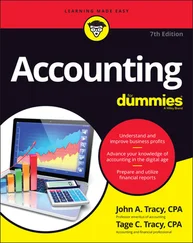Kenneth W. Boyd - Cost Accounting For Dummies
Здесь есть возможность читать онлайн «Kenneth W. Boyd - Cost Accounting For Dummies» — ознакомительный отрывок электронной книги совершенно бесплатно, а после прочтения отрывка купить полную версию. В некоторых случаях можно слушать аудио, скачать через торрент в формате fb2 и присутствует краткое содержание. Жанр: unrecognised, на английском языке. Описание произведения, (предисловие) а так же отзывы посетителей доступны на портале библиотеки ЛибКат.
- Название:Cost Accounting For Dummies
- Автор:
- Жанр:
- Год:неизвестен
- ISBN:нет данных
- Рейтинг книги:4 / 5. Голосов: 1
-
Избранное:Добавить в избранное
- Отзывы:
-
Ваша оценка:
- 80
- 1
- 2
- 3
- 4
- 5
Cost Accounting For Dummies: краткое содержание, описание и аннотация
Предлагаем к чтению аннотацию, описание, краткое содержание или предисловие (зависит от того, что написал сам автор книги «Cost Accounting For Dummies»). Если вы не нашли необходимую информацию о книге — напишите в комментариях, мы постараемся отыскать её.
Cost Accounting For Dummies
Cost Accounting For Dummies
Cost Accounting For Dummies — читать онлайн ознакомительный отрывок
Ниже представлен текст книги, разбитый по страницам. Система сохранения места последней прочитанной страницы, позволяет с удобством читать онлайн бесплатно книгу «Cost Accounting For Dummies», без необходимости каждый раз заново искать на чём Вы остановились. Поставьте закладку, и сможете в любой момент перейти на страницу, на которой закончили чтение.
Интервал:
Закладка:
Consider revenue. If you need to make a judgment on when to recognize revenue, choose to delay recognition. Delay posting the revenue until you’re sure the revenue has been earned. That decision is considered the conservative one, because it makes your financial statements less attractive to a reader.
Okay, now consider expenses. You should recognize expenses sooner than later. In the section “ Previewing inventoriable costs,” marketing costs are recognized immediately. That’s because the accountant can’t justify delaying the expenses to a later period. Posting more expenses sooner makes your financial statements less attractive.
Chapter 3
Using Cost-Volume-Profit Analysis to Plan Your Business Results
IN THIS CHAPTER
 Using the breakeven point to forecast desired sales and profit
Using the breakeven point to forecast desired sales and profit
 Computing contribution margin to cover fixed costs
Computing contribution margin to cover fixed costs
 Determining sales to achieve a target net income
Determining sales to achieve a target net income
 Deciding whether or not to advertise
Deciding whether or not to advertise
 Figuring out product prices to increase profit
Figuring out product prices to increase profit
C ost-volume-profit analysis (CVP) is a tool you can use to analyze your costs and plan for a reasonable profit. The CVP formula is simple, and using it is as easy as plugging in numbers as assumptions and seeing where your profit ends up.
Cost-volume-profit works for enterprises of all sizes. Take the neighborhood lemonade stand as an example. To set up a lemonade stand on the sidewalk, you’ll have costs. (“It takes money to make money.”) Those costs include lemons, sugar, water, stand construction, advertising, and so on.
Assume your lemonade stand startup costs total $30. You decide to sell each glass of lemonade for $1. How many glasses do you need to sell to recover all your costs? At what point would each lemonade sale create a profit? If your goal were to earn $20 in an afternoon, how many glasses would you need to sell? You can answer these questions using cost-volume-profit.
Understanding How Cost-Volume-Profit Analysis Works
A little comprehension goes a long way. I work with many small-business clients who use cost-volume-profit analysis, but they don’t know the terminology or how it really works. To illustrate, one client, Barb, owned an advertising premium company, producing and selling promotional items. She made items such as T-shirts, water bottles, bumper stickers, and anything with a company logo that would help promote a company’s product or service.
Barb knew the company’s total fixed costs. In fact, she could recite the cost of her lease, insurance, and loan interest off the top of her head. She also knew the variable cost she would incur for every item she produced. Finally, she had a sales amount in mind every month that she hoped to achieve. Barb knew how much profit she would generate if she hit that sales number.
Barb’s problem was that all these facts and numbers were swimming around in her head and not organized on paper. She needed a simple tool to analyze costs, sales (volume), and profit in one place. That’s the value of cost-volume-profit analysis. An owner or manager can have all three calculations in one formula and understand how they affect one another. So when you understand cost-volume-profit, you’ve added a powerful analytical tool to your arsenal.
Calculating the breakeven point
Cost-volume-profit analysis starts with the breakeven point. Breakeven answers this question: “What’s the amount I need to sell to cover all my costs?” When you open the front door of your business on the first day of a new month, your first concern is likely to be how much you have to sell to at least cover all costs for that month. At a minimum, you don’t want to lose money.
It doesn’t matter whether you’re selling a few glasses of lemonade or manufacturing automobiles. Either way, the breakeven point has three simple elements:
It includes fixed costs and variable costs.
It includes sales, either units of product sold, or the total dollar amount of sales (revenue). The term volume refers to the level of sales.
It assumes profit of zero.
 The reason for the name breakeven point is pretty obvious. It’s the point where you neither make nor lose money. It’s the point where you break even.
The reason for the name breakeven point is pretty obvious. It’s the point where you neither make nor lose money. It’s the point where you break even.
Examine the elements required to find the breakeven point: Fixed costs remain constant, regardless of the volume of products or services you provide. Variable costs increase or decrease proportionately with the number of products you sell or services you deliver. The total variable costs, of course, increase as you produce more products or provide more services, and vice versa if fewer items, products, or services are provided. Sales is the total dollar amount received for your product or service. Finally, profit represents sales less all your costs.
Okay, if you want to split hairs, there’s an exception about fixed costs that is important in analyzing cost-volume-profit: relevant range (see Chapter 1). But in most cases, the level of activity stays within the relevant range for fixed costs.
What makes the breakeven point so important is that every sale above your breakeven point generates a profit. If your breakeven point is 100 units, you make a small profit when you sell the 101st unit. That’s good! After you know your breakeven point, you can plan the level of sales you need to generate a specific amount of profit.
What goes up can come down. If you sell only 99 units, you have a small loss. That’s not good! The fewer units you sell, the larger your loss.
The breakpoint formula
Before you start selling a product, you need to know the fixed costs, the variable costs, and the sale price. See Chapter 2for more on cost terms. You can use the cost and price information to determine how many units you need to sell to recover all your costs — your breakeven point. The formula is
Profit ($0) = sales – variable costs – fixed costs
Failing to get a grip on profit, loss, and breakeven point can be funny, at least on TV. Saturday Night Live did a skit years ago about “The Change Bank.” Its only business was to make change, and its tag line was “We can meet all of your change needs.” The owner was asked: “How do you make money just making change?” “Volume!” says the owner.
The joke in the Change Bank skit is that regardless of how much business you do, there’s no profit in making change for people.
A case in point (breakeven point, that is)
You own a software company, and you’re thinking about buying a booth at a technology trade show. You hope to sell your product to trade-show visitors. Before deciding to attend, you benefit from a little breakeven analysis.
You might say to yourself, “I’m not getting on a plane unless I can at least cover all my expenses. How many units do I need to sell to cover all expenses?”
Читать дальшеИнтервал:
Закладка:
Похожие книги на «Cost Accounting For Dummies»
Представляем Вашему вниманию похожие книги на «Cost Accounting For Dummies» списком для выбора. Мы отобрали схожую по названию и смыслу литературу в надежде предоставить читателям больше вариантов отыскать новые, интересные, ещё непрочитанные произведения.
Обсуждение, отзывы о книге «Cost Accounting For Dummies» и просто собственные мнения читателей. Оставьте ваши комментарии, напишите, что Вы думаете о произведении, его смысле или главных героях. Укажите что конкретно понравилось, а что нет, и почему Вы так считаете.












